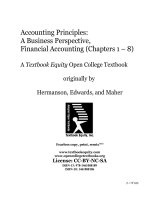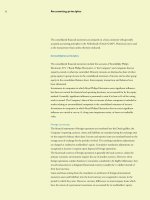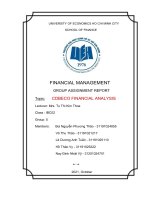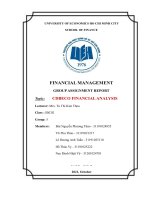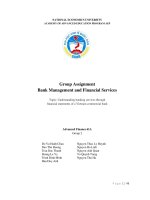report group assignment cc101 accounting principles financial index analysis
Bạn đang xem bản rút gọn của tài liệu. Xem và tải ngay bản đầy đủ của tài liệu tại đây (664.14 KB, 28 trang )
<span class="text_page_counter">Trang 1</span><div class="page_container" data-page="1">
TRƯỜNG ĐẠI HỌC FPT - THÀNH PHỐ HỒ CHÍ MINH
<b>REPORT GROUP ASSIGNMENT</b>
<b>ACC101- ACCOUNTING PRINCIPLES</b>
<b>FINANCIAL INDEX ANALYSIS</b>
Class: ACC101_3W Group: No Idea
No Name of group member Student ID Contribution ( 100% )
</div><span class="text_page_counter">Trang 2</span><div class="page_container" data-page="2">
<b>TABLE OF CONTENT</b>
<b>I. INTRODUCTION__________________________________________________3 </b>
1. Saigon Hotel Corporation
2. Dam Sen Water Park Corporation (DASECO)
3. Dong A Construction Investment and Trading Joint Stock Company
<b>II. DATA ANALYSIS_________________________________________________4 i. Saigon Hotel Corporation</b>
<b>III. GENERAL ASSESSMENTS_______________________________________21</b>
I. CRITERIA FOR ABILITY TO PAY. II. PERFORMANCE INDICATORS. III. PROFITABILITY CRITERIA.
IV. THE INDEX REFLECTS THE FINANCIAL STRUCTURE AND ASSET STRUCTURE.
<b>IV. APPENDIX_____________________________________________________27 V. REFERENCES___________________________________________________28 </b>
</div><span class="text_page_counter">Trang 3</span><div class="page_container" data-page="3"><b>I.INTRODUCTION1. Saigon Hotel Corporation</b>
- With a history of over 50 years, Saigon Hotel is a long-standing hotel in Ho Chi MinhCity. Saigon Hotel Corporation is a company based in Vietnam that operates in the hotel industry.
- The company manages a hotel in Ho Chi Minh City, Vietnam, to provide accommodation and resort services for tourists.
- The company also offers office space for rent, operates restaurants, and provides domestic and international travel services.
- The company provides passenger transportation services by road, laundry services, karaoke services, massage services, and other entertainment services.
- Additionally, the company is involved in the wine and tobacco business.
<b>2. Dam Sen Water Park Corporation (DASECO)</b>
- Dam Sen Water Park Corporation is a Vietnam-based company that operates in the resort and entertainment industry. The company engages in the business of Dam Sen Water Park, which includes a water park and a dinosaur park.
- The company also operates two full-service restaurants and three fast-food restaurantswithin Dam Sen Water Park.
- Other services provided include swimwear rental, photography services, and advertising services. Additionally, the company sells souvenir items.
- In the fiscal year ending on December 31, 2012, 72.29% of the company's revenue came from operating the water park and dinosaur park. As of December 31, 2012, the company was an affiliate of Phu Tho Tourism Services Limited Liability Company.
<b>3.Dong A Construction Investment and Trading Joint Stock Company</b>
- Dong A Construction Investment and Trading Joint Stock Company known as Dong A Hotel Group Joint Stock Company is a company based in Vietnam primarily engaged in the hotel industry.
- The main business activities of the company include operating accommodation establishments such as resorts and hotels, leasing offices, exhibition halls, conference venues, and tennis courts.
- The company also manages restaurants, bars, and drinking establishments, as well as provides tour services.
- Additionally, the company distributes goods through supermarkets and grocery stores,engages in wholesale and retail trade of construction materials, constructs commercialbuildings, and offers architectural services.
</div><span class="text_page_counter">Trang 4</span><div class="page_container" data-page="4"><b>II. DATA ANALYSISi. Saigon Hotel Corporation</b>
<b>1. Overview</b>
Address: No. 41-47 Dong Du - Ben Nghe Ward - District 1 - HCMCTax code: 0300850255
Stock code: SGHPhone: (84.28) 3829 9734Fax: (84.28) 3829 1466Email: : Https://saigonhotel.com.vn
Established: 1968
<b>2. Index analysis in ( 2018 / 2019 /2020 / 2021 / 2022)2.1. Debt to assets ratio </b>
<b>Result: The fluctuation in the debt to assets ratio suggests a dynamic financial strategy by Saigon </b>
Hotel. A decreasing ratio may indicate a conservative financial approach, while an increasing ratio could imply a more aggressive strategy with higher financial leverage. It's important to consider industry benchmarks and specific business circumstances when interpreting these changes. Additionally, monitoring trends in subsequent years can provide a more comprehensive understandingof the company's financial management.
</div><span class="text_page_counter">Trang 5</span><div class="page_container" data-page="5"><b>Profit margin</b> 0,42 0,40 0,25 0,25 0,32
<b>Result: The fluctuation in profit margins suggests that Saigon Hotel experienced variations in its </b>
financial performance over the years. The drop in 2020 might ave been a challenging period, but the hsubsequent increase in 2022 is a positive sign. Further analysis, such as understanding the factors influencing these changes and comparing them with industry benchmarks, can provide a more comprehensive assessment of Saigon Hotel's financial health.
<b>2.3. Gross margin ratio </b>
<b>Result:The significant drop in 2020 and subsequent recovery in 2022 warrant further investigation </b>
into the factors influencing the cost structure, production efficiency, and overall financial health of Saigon Hotel during these periods. Understanding the reasons behind these changes can provide valuable insights into the company's operational dynamics and strategic decisions.
<b>Result: Overall, the analysis of inventory turnover indicates fluctuations over the years, with the </b>
highest turnover occurring in 2022. Understanding the reasons behind these changes, such as shifts in consumer behavior, market dynamics, or supply chain improvements, can provide valuable insights into Saigon Hotel's operational efficiency and adaptability to market conditions.
<b>2.5. Day's sale in inventory</b>
Currency unit: VND
</div><span class="text_page_counter">Trang 6</span><div class="page_container" data-page="6">Year <b>20182019202020212022Average </b>
<b>Result: Overall, the days' sales in inventory analysis highlights the efficiency of Saigon Hotel in </b>
managing its inventory. The decreasing trend from 2018 to 2019 indicates improved efficiency, and the subsequent fluctuations in the following years may be influenced by various external and internal factors. It's essential to consider industry benchmarks and specific business circumstances when interpreting these changes.
<b>2.6. Day's sale in uncollected</b>
Currency unit: VND
<b>Average accounts receivables </b>
<b>Net sales</b> 45.439.591.448,00 50.383.315.539,00 17.580.851.374,00 17.933.162.805,00 28.079.031.839,00
<b>Day's sale inuncollected</b>
<b>Result:In 2018, Saigon Hotel had an average collection period of 41.64 days, indicating the average </b>
time it took to collect payments after a sale.The Days Sales Outstanding decreased slightly in 2019 to 39.055 days. A lower DSO suggests a more efficient collection process, with the company collecting payments more quickly.In 2020, the DSO increased to 47.104 days, suggesting a longer average time to collect payments. This may be influenced by various factors such as changes in customer payment behavior or economic conditions.In 2022, the DSO decreased to 86.097 days, but it remains relatively high compared to previous years. This suggests ongoing challenges in the collection process, and further examination is needed.
<b>2.7. Accounts receivable turnover</b>
Currency unit: VND
</div><span class="text_page_counter">Trang 7</span><div class="page_container" data-page="7">Year <b>20182019202020212022</b>
<b>Net sales</b> 45.439.591.448,00 50.383.315.539,00 17.580.851.374,00 17.933.162.805,00 28.079.031.839,00
<b>Beginning receivables</b>
4.4448.006.533 3.406,034,919 9,869.091.322 5.047.652.572 3.628.243.267
<b>Ending receivables</b>
5.279.786.798 9,599,866,609 5.047.652.572 3.628.243.267 3.436.101.145
<b>Average accounts receivables</b>
<b>Accounts receivable turnover</b>
<b>Result: Overall, the analysis of accounts receivable turnover suggests fluctuations over the years. </b>
The significant drop in 2020 and subsequent recovery in 2022 highlight the impact of external factors on the company's ability to collect payments promptly. Further investigation into the reasons behind these changes and potential adjustments in credit policies or collection strategies may provide additional insights into Saigon Hotel's financial health.
<b>2.8. Total assets turnover</b>
Currency unit: VND
<b>Net sales </b> 45.439.591.448,00 50.383.315.539,00 17.580.851.374,00 17.933.162.805,00 28.079.031.839,00
<b>Beginning total assets</b>
161.729.015.097 172.119.695.122 186.206.885.718 179,052,635.633 184.802.124.312
<b>Ending total assets</b>
172.119.695.122 187.169.758.188 179,051,635.633 184.802.124.312 196.859.328.298
<b>Average Total Assets</b>
166,924B 179,644B 182,628B 181,927B 190,830B
<b>Total assets turnover </b>
<b>Result:2.9. Current ratio</b>
Currency unit: VND
</div><span class="text_page_counter">Trang 8</span><div class="page_container" data-page="8">maintain liquidity and potentially invest in short-term opportunities.
<b>2.10. Return on assets (ROA)</b>
<b>Result: The Return on Assets for Saigon Hotel experienced fluctuations over the years. The </b>
significant drop in 2020 followed by a recovery in 2022 indicates the impact of external factors on thecompany's ability to generate profits from its assets. Further analysis into the specific drivers behind these changes can provide insights into the company's financial performance and strategic decisions.
<b>Result: There was a decline in 2020 and 2021, there was a subsequent recovery in 2022. Monitoring </b>
quick assets is crucial for understanding a company's short-term liquidity and its ability to meet immediate financial obligations
<b>2.12 Times interest earned</b>
Currency unit: VND
</div><span class="text_page_counter">Trang 9</span><div class="page_container" data-page="9">Operating income 16.20B 15.88B -4,35B -3,54B 2,35BIncome Taxes -4,8B -5,02B −731.88
<b>-Result: Times Interest Earned ratio is undefined in years where the interest expense is zero, as </b>
division by zero is mathematically undefined. Additionally, in 2022, the interest expense is negative, which is unusual
<b>ii. </b>
<b>Dam Sen Water Park Corporation (DASECO)</b><b>1. Overview</b>
Address: No. 3, Hoa Binh Street, Ward 3, District 11, Ho Chi Minh CityTax code: 0302844200
Stock code: DSNPhone: (84.28) 3858 8418Fax: (84.28) 3858 8419
Email: : Established: 1998
<b>2. Index analysis in (2020 / 2021 / 2022)2.1. Debt to assets ratio </b>
Currency unit: VND
<b>Total debt</b> 11.431.634.067 27.942.069.065 18.110.819.623 17.750.686.629 32.537.566.198
<b>Total assets</b> 263.961.073.928 276.032.880.458 224.221.856.297 200.709.067.361 283.335.900.734
<b>Result: </b>From 2018 to 2022, the company's total debt and total assets have both increased. The debt to assets ratio started at 0.04 in 2018, peaked at 0.10 in 2019, and after a slight decrease in 2020 to 0.08, it increased again in the following years, reaching 0.11 in 2022.
</div><span class="text_page_counter">Trang 10</span><div class="page_container" data-page="10">This indicates that the proportion of assets financed by debt has been generally increasing, suggesting that the company may be taking on more debt relative to its assets over time.
<b>2.3. Gross margin ratio </b>
Currency unit: VND
<b>Net sales </b> 231.038.447.125 235.603.761.445 97.564.516.328 66.111.208.222 246.888.302.262
<b>Cost of goods sold </b> 75.807.775.655 84.322.261.407 33.210.465.520 26.823.434.857 80.412.109.756
<b>Result: </b>The company has maintained a relatively stable gross margin ratio over the period, with minor fluctuations, suggesting consistent profitability in terms of the relationship between sales and the cost of goods sold. The year 2021 appears to have been more challenging, with the lowest margin ratio of the period, but there was a recovery in 2022, returning to the levels seen in 2018.
</div><span class="text_page_counter">Trang 11</span><div class="page_container" data-page="11"><b>Average inventory</b> 839.085.696 789.996.654 667.791.931 620.766.730 834.686.767
<b>Result: </b>The fluctuation in inventory turnover across these years could reflect changes in the company's sales effectiveness, inventory management practices, or broader market conditions. The decrease in 2020 and 2021 might correspond to the global impact of the COVID-19 pandemic on supply chains and consumer demand. The rebound in 2022 suggests a return to more normal operations and improved inventory management after navigating the challenges of the previous years.
<b>2.5. Day's sale in inventory</b>
Currency unit: VND
<b>Ending inventory</b> 834.992.568 745.000.740 590.583.121 650.950.339 1.018.423.195
<b>Cost of goods sold</b> 75.807.775.655 84.322.261.407 33.210.465.520 26.823.434.857 80.412.109.756
<b>Result: </b>The increase in the day's sales in inventory in 2020 and 2021 could correspond with the effects of the COVID-19 pandemic on sales and supply chains, reflecting that the inventory was turning over more slowly. The improvement in 2022 might suggest that the company has started to overcome these challenges and is moving inventory more quickly again.
<b>2.6. Day's sale in uncollected</b>
<b>2.7. Accounts receivable turnover</b>
Currency unit: VND
</div><span class="text_page_counter">Trang 12</span><div class="page_container" data-page="12"><b>2.8. Total assets turnover</b>
Currency unit: VND
<b>Net sales</b> 231.038.447.125 235.603.761.445 97.564.516.328 66.111.208.222 246.888.302.262
<b>Average total assets</b> 253.536.112.892 269.996.977.193 250.127.368.378 212.465.461.829 242.022.484.048
<b>Result: </b>The trend suggests that after a couple of years of lower efficiency in using assets to generate sales (which might have been influenced by the economic impact of the COVID-19 pandemic), the company has significantly improved in 2022, either through better asset management, increased sales, or a combination of both.
<b>2.10. Return on assets (ROA)</b>
</div><span class="text_page_counter">Trang 17</span><div class="page_container" data-page="17">the company reducing the average number of days required to sell its inventory to 57.42 days.A lower DSI is generally considered more efficient as it indicates that the company is selling its inventory more quickly. This can reduce holding costs, minimize the risk of obsolescence, and free up capital for other uses. The increase in DSI in the third year may be a cause for concern. A higher DSI can indicate that the company is holding onto its inventory for longer periods, which can lead to higher holding costs and increased risks of obsolescence.
<b>2.6. Day's sale in uncollected</b>
67.604.326.121 43.198.716.812,5 15.038.811.082,5 95.687.887.195,5 <sub>,5</sub><sup>224.213.617.610</sup>
<b>Net sales</b> 198.369.899.938 117.452.173.942 12.337.366.562 691.624.639.904 25.664.871.455
<b>Day's sale in</b>
<b>Result: Days sales uncollected (DSU) is important for assessing how effectively a company </b>
is managing its accounts receivable. The DSU of 3188.72 days in 2022 shows a very surprising improvement. A DSU of 3188.72 days in 2022 represents an increase in the average time to collect payments. Changes in DSU can be affected by company credit policies, customer payment behavior or changes in economic conditions. A lower DSU is often preferred because it shows the company is collecting payments faster, improving cash flow and liquidity.
<b>2.7. Accounts receivable turnover</b>
</div><span class="text_page_counter">Trang 18</span><div class="page_container" data-page="18"><b>accounts receivables</b>
67.604.326.121 43.198.716.812,5 15.038.811.082,5 95.687.887.195,5 224.213.617.610,5
<b>Accounts receivable turnover</b>
<b>Result: The Accounts Receivable Turnover ratio provides insights into how efficiently a </b>
compan manages its accounts receivable. Accounts Receivable Turnover of 2.93 in 2018 indicates the highest turnover rate of 5 years. The decrease in turnover from the second to the five year may be a cause for concern. A lower turnover ratio suggests that the company is taking longer to collect payments, which can lead to cash flow challenges and strain working capital.
<b>2.8. Total assets turnover</b>
717.447.385.662,5 675.073.185.830,5 618.777.388.248,5 870.314.341.311,5 1.144.308.700.750
<b>Total assets turnover </b>
<b>Result: The Total Assets Turnover ratio provides insights into how efficiently a company </b>
uses its assets to generate revenue. A higher turnover ratio in 2021 is generally considered more efficient. It indicates that the company is generating more revenue per unit of assets. The decrease in 2022 may cause concern as a lower turnover ratio suggests that the company is less efficient in utilizing its assets to generate revenue.
<b>2.9. Current ratio</b>
Currency unit: VND
</div>